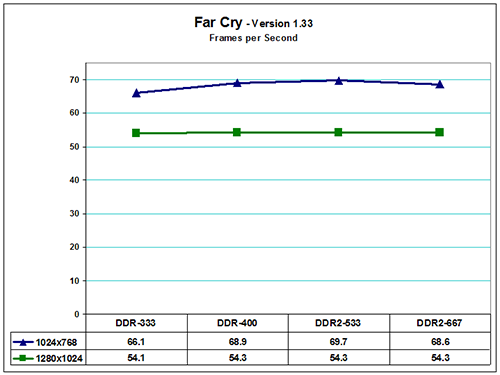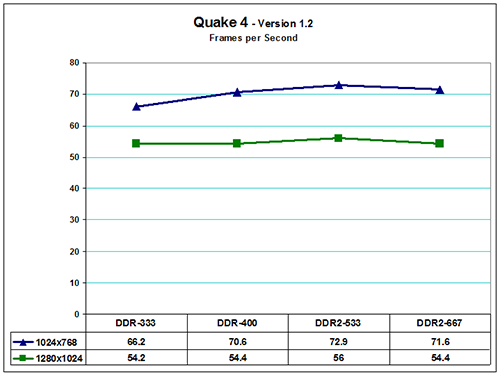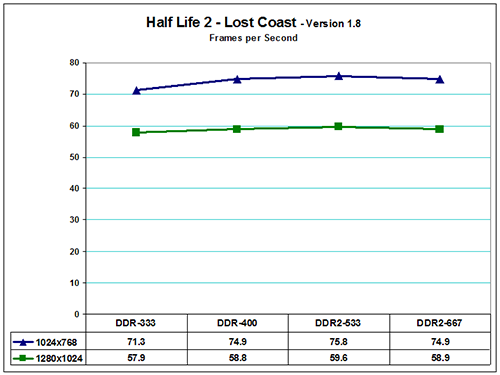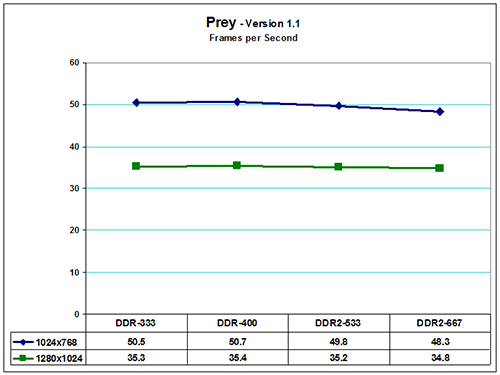ASRock 775Dual-VSTA: Does DDR2 matter?
by Gary Key on August 8, 2006 6:35 AM EST- Posted in
- Motherboards
Game Performance Comparison
While Sandra and Super Pi provide useful information on how memory performs without the influence of other components, our first round of real world tests has shown there is not a large difference in performance between DDR2 and DDR memory on this particular platform. However, our next set of real-world benchmarks consists of gaming benchmarks.
We utilize Far Cry, Half-Life 2 and Quake 4 in our normal memory testing because they are sensitive to memory changes. We are adding Prey and Serious Sam II to our benchmark mix because they are typically very GPU dependent and we will see the effects of our memory choices on these games. We tested at both 1024x768 and 1280x1024 at High Quality settings but without anti-aliasing or antistrophic filtering enabled. We feel like these settings are representative of a platform at this price point and believe most users would be utilizing a 17" or 19" monitor with this setup.





Our three memory sensitive games show a slight difference in results at 1024x768 but are GPU limited at 1280x1024 for all intents and purposes. The performance pattern is similar to the synthetic benchmarks with the DDR2-533 setting performing best overall. The DDR2-667 and DDR-400 configurations basically end in a tie with the DDR-333 finishing last. Our two GPU limited games actually favor the DDR-400 memory setup although the scores across the board are well within our margin of test error.
Overall, gaming performance is fine with low latency DDR-400 memory on this platform. Even DDR-333 provides for acceptable performance, particularly if you're looking to upgrade from an old socket A or 478 system. In that case, you might also want a new GPU, but we'll take a look at PCIe vs. AGP performance in part two of this series.
While Sandra and Super Pi provide useful information on how memory performs without the influence of other components, our first round of real world tests has shown there is not a large difference in performance between DDR2 and DDR memory on this particular platform. However, our next set of real-world benchmarks consists of gaming benchmarks.
We utilize Far Cry, Half-Life 2 and Quake 4 in our normal memory testing because they are sensitive to memory changes. We are adding Prey and Serious Sam II to our benchmark mix because they are typically very GPU dependent and we will see the effects of our memory choices on these games. We tested at both 1024x768 and 1280x1024 at High Quality settings but without anti-aliasing or antistrophic filtering enabled. We feel like these settings are representative of a platform at this price point and believe most users would be utilizing a 17" or 19" monitor with this setup.





Our three memory sensitive games show a slight difference in results at 1024x768 but are GPU limited at 1280x1024 for all intents and purposes. The performance pattern is similar to the synthetic benchmarks with the DDR2-533 setting performing best overall. The DDR2-667 and DDR-400 configurations basically end in a tie with the DDR-333 finishing last. Our two GPU limited games actually favor the DDR-400 memory setup although the scores across the board are well within our margin of test error.
Overall, gaming performance is fine with low latency DDR-400 memory on this platform. Even DDR-333 provides for acceptable performance, particularly if you're looking to upgrade from an old socket A or 478 system. In that case, you might also want a new GPU, but we'll take a look at PCIe vs. AGP performance in part two of this series.










55 Comments
View All Comments
preacherman - Tuesday, August 8, 2006 - link
What would be intresting would be a maybe running at least the synth benchmarks on another C2D mobo.. with the same CPU,HDD;DDR2 etc etc.This would show us if the mobo as a whole runs at a performance handicap to others mobo or.. as I would hope.. basicly its up or near there in performance with most other C2D mobos with or without DDR2.
If that is the case then the mobo is truly very good for those of us not wanting to shell out 250e+ for 2x1Gb DDR2 when we already have 2x512Mb DDR sat in our current rigs so we could spend that money on CPU/GPU as you wrote in your atricle and maybe get DDR2 later as and when funds become available.
thanks.
Gary Key - Tuesday, August 8, 2006 - link
You will see this in the final comparison article. The general performance of the board is about the same as we reported in our Conroe Buying Guide. However, the 1.5 bios has improved performance in some areas.
yacoub - Tuesday, August 8, 2006 - link
I am surprised how little advantage DDR2 has over DDR memory. Very interesting. Was the difference greater from SDR to DDR? I forget.Locutus465 - Tuesday, August 8, 2006 - link
I'm guessing a higher end board with a better memory controller might show DD2 in a better light.retrospooty - Tuesday, August 8, 2006 - link
The same can be said for DDR.MY DFI Lanparty NF4 runs my Corsair BH-5 chips at 260mhz@ 2-2-2-7 timings. DDR2@ 1000mhz@5-5-5 cant even beat that.
Wesley Fink - Tuesday, August 8, 2006 - link
We did a top-end DDR vs DDR2 on the AM2 at http://www.anandtech.com/cpuchipsets/showdoc.aspx?...">http://www.anandtech.com/cpuchipsets/showdoc.aspx?.... Of course, DDR2 bandwidth on the AM2 is huge, even though it doesn't always translate into real-world performance gains. Conroe is not nearly as efficient as AM2 on memory but still outperforms by a wide margin. In the AM2 article we found fast DDR400 and DDR2-533 roughly equivalent, with faster DDR2 speeds providing a bit more performance.It appears with Conroe on a VIA chipset DDR2-533 gains more, but real-world is still in the ball park with DDR400. That may be a commentary on the VIA chipset and may not apply to Intel or nVidia or ATI. However, this VIA board is the first to allow a DDR/DDR2 comparison with Conroe.
There are other boards for Dore 2 Duo coming that will support DDR on Core 2 Duo. For the value builder, it will be interesting to see how this board compares to some of those.
JarredWalton - Tuesday, August 8, 2006 - link
In some instances DDR was quite a bit faster than SDR. I think it gave about a 10% performance boost on average, and up to 20% in a few special cases. It's also worth noting that the ASRock does offer lower performance than other high-end DDR2 boards, but the price tradeoff makes it justifiable.yyrkoon - Sunday, August 20, 2006 - link
Well, if you go by pure synthetic benchmarks, DDR is 5x faster than SDRAM most of the time. Actual application performance, may be different.Calin - Tuesday, August 8, 2006 - link
DDR was quite a bit faster than DDR - just the way it is now with DDR2 and SDR. However, in the budget side of the equation, the processors weren't starved enough for bandwidth, so the difference was very small.I wonder what the results would have been if a faster processor would have been used.
Oh, and maybe the chipset/BIOS isn't optimized for DDR2 performance (as for DDR, all the performance that could have been squeezed in about three-four years of building chipsets was already there).
Jedi2155 - Tuesday, August 8, 2006 - link
Did you mean DDR was quite a bit faster than SDR and now with DDR2 with DDR?